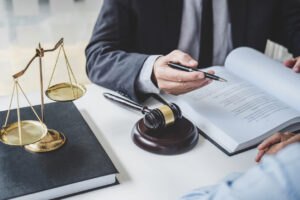
Evidence is anything that can be used to prove or disprove something. This could be testimony of a witness, photographs, documents, and more.
Not all types of evidence are admissible in court. The rules for what is and is not admissible in Florida courts are found in the Florida Evidence Code.
Understanding evidence in personal injury claims can help you be better prepared for what to expect in your case. An experienced personal injury attorney from Norden Leacox Accident & Injury Law can help you gather and analyze relevant evidence to strengthen your claim.
What Is Negligence?

Negligence, which essentially means “carelessness,” is the foundation for most personal injury claims.
To win a negligence case, you need to establish the following four elements:
- Duty of Care: You had an obligation to the defendant. In a car accident case, this duty could be to drive safely. In medical malpractice, it could mean performing a medical procedure like an appendectomy with skill.
- Breach of Duty: The defendant failed to meet their duty of care. This breach could be through an improper action, like running a red light or failing to act appropriately.
- Injury: You were harmed. You need to provide proof for every dollar you claim as damages.
- Causation: The defendant’s breach directly caused your injury, and it was a foreseeable result of their actions.
There are additional legal principles involved in cases like product liability, wrongful death, and workers’ compensation. Regardless of the claim, you must prove each element by the “preponderance of the evidence.”
The “Preponderance of the Evidence” Standard
A personal injury lawsuit differs from a criminal trial. Unlike the “beyond a reasonable doubt” standard in criminal cases, personal injury cases require you to prove your claim by a “preponderance of the evidence.” This means showing that your claim is more likely true than not or having at least a 51% likelihood of being accurate.
Common Types of Evidence
Common types of evidence used in personal injury lawsuits include the following:
- Eyewitness Testimony: Accounts from people who witnessed the event
- Expert Witness Testimony: Experts who can assess damages, reconstruct accidents, identify product defects, or determine medical malpractice
- Deposition Testimony: Sworn out-of-court testimony from witnesses, which can be used to challenge in-court testimony
- Police Reports: While not admissible in court, they can be useful in negotiations
- Medical Opinions: Professional assessments of your injuries
- Medical Records and Bills: Documentation to substantiate medical expenses
- Earnings Data: Information to calculate lost income
- CCTV Footage: Video evidence of the incident
- Photographs: Images of the accident scene, injuries, and property damage
- Insurance Policies and Documents: Copies of the insurance policies to prove coverage and the policy limits for damages
- Pain and Suffering Journal: A detailed journal of how your injuries affect your daily life can be useful in quantifying non-economic damages
Every personal injury case is distinct, meaning the evidence required in one instance might not be relevant in another. Despite this, the types of evidence commonly seen across different personal injury cases are often similar. For example, the evidence in car accident cases often mirrors that in slip and fall incidents, motorcycle or truck accidents, and workplace injuries.
Inadmissible Evidence
Certain evidence is not allowed in court due to long-standing legal principles.
The following are key types of evidence that are often found to be inadmissible in personal injury cases:
- Irrelevant Evidence: Only relevant evidence can be presented in court. For example, a victim’s sexual history may be found irrelevant in a sexual assault case.
- Probative vs. Prejudicial Evidence: Evidence must have more probative value (relevance and importance) than prejudicial effect (potential to unfairly sway the jury). For instance, graphic images in a wrongful death case might be excluded if they could unduly influence the jury, even though this evidence is relevant.
- Subsequent Remedial Measures: Evidence that a defendant fixed a hazardous condition after an incident cannot be used to prove the condition was dangerous before or that the property owner was negligent.
- Hearsay: Statements made outside of court cannot be used to prove the truth of the matter asserted. For example, a police report saying, “The defendant claimed the light was green,” is hearsay. Instead, the officer would need to testify in court. However, there are many exceptions to the hearsay rule.
Navigating rules of evidence can be challenging on your own. A skilled personal injury attorney will be familiar with these rules and can make the process more manageable.
A Skilled Orlando Personal Injury Attorney Can Help You Gather and Analyze Evidence
Navigating the Florida Evidence Code can be complex. A proficient Orlando personal injury lawyer from Norden Leacox Accident & Injury Law should have a thorough understanding of these rules and use them to benefit your case.
Under a contingency fee arrangement, you don’t pay legal fees unless your personal injury lawyer secures a win or settlement for you. Contact us online or call us at (407)-801-3000 to consult with an Orlando personal injury attorney to understand what evidence can be used to prove your personal injury claim.
